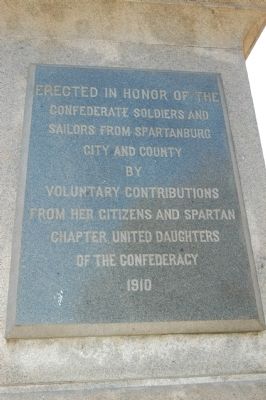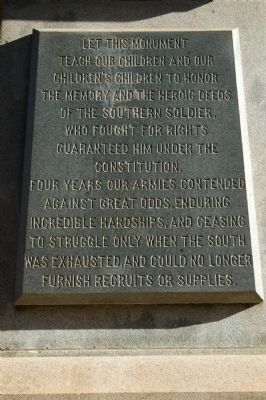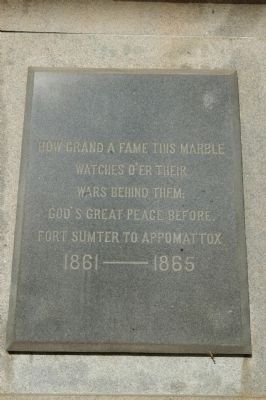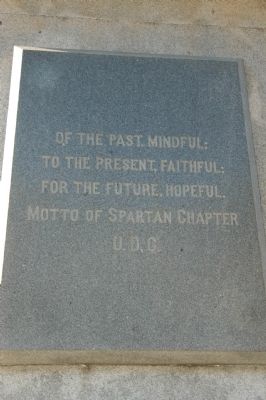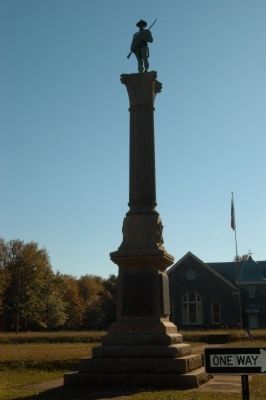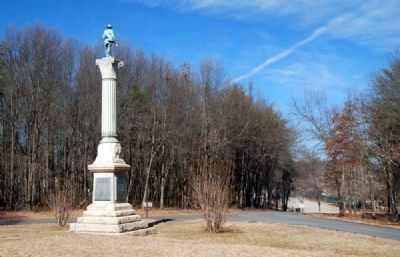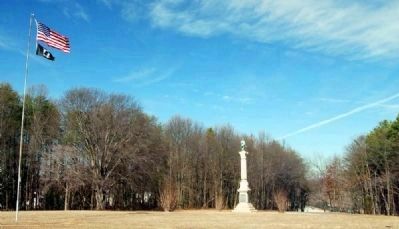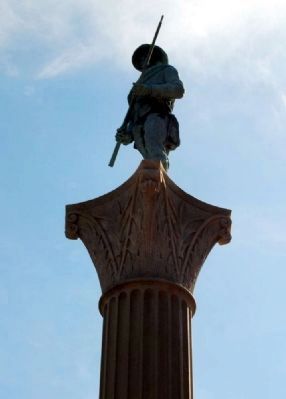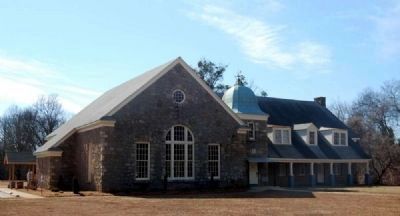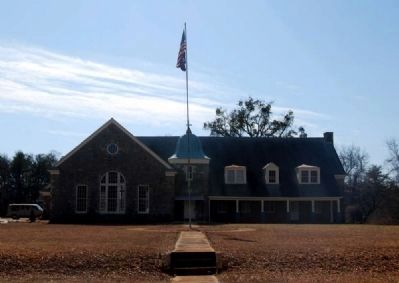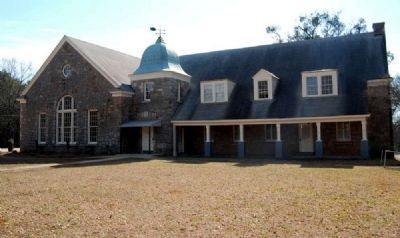Spartanburg in Spartanburg County, South Carolina — The American South (South Atlantic)
Spartanburg Confederate War Monument
Inscription.
[East Facing Side]
Confederate Soldiers and
Sailors from Spartanburg
City and County
by
voluntary contributions
from her citizens and Spartan
Chapter United Daughters
of the Confederacy
1910
[North Facing Side]
teach our children and our
children's children to honor
the memory and the heroic deeds
of the Southern Soldier,
who fought for rights
guaranteed him under the
Constitution.
Four years our armies contended
against great odds, enduring
incredible hardships, and ceasing
to struggle only when the South
was exhausted, and could no longer
furnish recruits and supplies.
[West Facing Side]
watches o'er their
wars behind them;
God's great peace before.
Fort Sumter to Appomattox
1861———1865
[South Facing Side]
To the present, faithful;
For the future, hopeful.
Motto of Spartan Chapter
U.D.C.
Erected 1910 by United Daughters of the Confederacy.
Topics and series. This historical marker and monument is listed in this topic list: War, US Civil. In addition, it is included in the United Daughters of the Confederacy series list. A significant historical year for this entry is 1910.
Location. 34° 56.052′ N, 81° 54.87′ W. Marker is in Spartanburg, South Carolina, in Spartanburg County. Marker is on West Park Drive, half a mile south of Converse Street, on the right when traveling south. Across from Duncan Field Baseball Stadium, on the front lawn of the American Legion Post No. 29 Building. Touch for map. Marker is at or near this postal address: 94 West Park Drive, Spartanburg SC 29306, United States of America. Touch for directions.
Other nearby markers. At least 10 other markers are within 2 miles of this marker, measured as the crow flies. Old City Cemetery (approx. 0.4 miles away); Spartanburg County War Memorial (approx. half a mile away); Purple Heart Memorial (approx. half a mile away); American Legion Memorial Archway (approx. half a mile away); Hampton Heights Historic District (approx. 0.9 miles away); Church of the Advent (approx. 1.2 miles away); First Presbyterian Church of Spartanburg, S.C. (approx. 1.3 miles away); Converse Heights (approx. 1.4 miles away); Walter Hyatt / DesChamps Hood (approx. 1.4 miles away); Dexter Edgar Converse (approx. 1.4 miles away). Touch for a list and map of all markers in Spartanburg.
More about this monument. There is stone pillar with the American Legion symbol on it that marks the driveway the monument is on.
Also see . . . American Legion Building. The Spartanburg Post 28 American Legion Building is significant for its architecture, which was designed by the internationally-recognized engineering firm Lockwood, Greene & Company, and the techniques used by the Works Progress Administration (WPA) in its construction. (Submitted on February 23, 2011, by Brian Scott of Anderson, South Carolina.)
Additional commentary.
1. American Legion Building
The American Legion Building is a large stone masonry meeting hall located in the Duncan Park area of Spartanburg. The building, ranging from one-and-one-half stories on the facade to two-and-one-half on the rear elevation, is surrounded by open lawn and wooded areas and is not visible from the street. The Works Progress Administration (WPA) constructed the building as a meeting hall and office building in 1936-1937 for members of the American Legion Post 28 in Spartanburg County. The building still serves as a meeting hall for members of the American Legion, as well as the community.
The internationally-recognized engineering firm of Lockwood, Greene & Company designed the building. Founded by Amos D. Lockwood
(1811-1884) and Stephen Greene as early as 1873 in Lewiston, Maine, the firm organized as Lockwood, Greene & Company in 1882 in Providence, Rhode Island, and soon became a preeminent concern in textile mill design and engineering in the eastern United States. A Southern headquarters was opened in Greenville, South Carolina, in 1898, but closed in 1912 in favor of an Atlanta office as the firm's base of operations in the South. When Lockwood Green opened an office in Spartanburg in 1924, it located in the newly-built Montgomery Building, a skyscraper which the firm had designed and built.
The American Legion Building was constructed in the Colonial Revival style by the WPA using granite laid in random courses and taken from a quarry in Pacolet, a town located to the east of Spartanburg. It is a large complex gable-front-and-wing building, the roof of which is asphalt-shingled and asymmetrical in design. With roof extensions on at least three elevations, the facade's roofline above the porch is pierced by a gable dormer with a single window, flanked by two hip roofed dormers with paired windows. The entire building features a boxed cornice and returns. Stone chimneys are located at the center of the lateral gable end [north] and at the rear center.
The building's focal point, a central polygonal entry tower, is in the form of an oversized cupola. It features canted
corners and a belcast metal roof with weathervane. The entrance, consisting of a six-panel door with stone arched lintel, is located in the entry tower. To the lower left of the six-panel is a cornerstone laid by Governor Olin D. Johnston in a ceremony on June 15, 1936. A small double-hung sash window is above the door.
To the left of the entrance and projecting slightly is a large gable-front block with a tripartite window, the center unit of which is a large arched Diocletian window. The flanking parts are twelve-over-twelve, double-hung sash windows. Centered in the gable above is a circular vent. The same fenestration is reflected on the rear of opposing gable.
To the right of the entrance is a five-bay wide porch, featuring masonry pier and wood post supports. There are four double-hung sash windows within the porch, with a secondary front entrance located between the third and fourth windows.
There is another entrance in the rear of the building, which leads into the kitchen area. To the left of this entrance is the only place where the building exhibits three stories above grade. The basement level, located visually below a stone water table on the exterior of the building, contains an apartment that has been occupied sporadically by a groundskeeper. Two additional entrances access the basement level. The next two floors feature six-over-six, double-hung sash windows. The uppermost windows pierce the cornice line and are in the form of wall dormers.
One of the most notable aspects of the building's interior is the large ballroom to the left of the front entrance. Floors in this room and throughout the building are hardwood except for the kitchen and bathrooms, which have tile floors. The ballroom, which is the room most often used by the American Legion and the community, is large and open, with a stone arched alcove and dais at the center of the long side wall. The tripartite windows on both ends of the room allow plenty of light to pass into the room.
The remainder of the rooms are smaller and dedicated to office space. both the Legion and the women's auxiliary meet in rooms at the opposite ends of the building from the ballroom, with the men meeting upstairs, and the women's auxiliary meeting downstairs. The downstairs walls are wood paneled and painted white. The upstairs walls are plastered.
Little has changed since the building first opened in 1937. On February 8, 2001, the Spartanburg City Historical and Architectural Review Board (HARB) designated the building and its grounds a local historic site, which was approved by Spartanburg City Council. The addition of air conditioning units and updated bathrooms are the only major changes to date.
Plans are currently underway to bring the building
up to code. New firewalls are being installed, handicapped ramps are being added, and additional parking areas are to be built. All of this work has had the approval of the HARB, and is taking place under the supervision of Donnie Love, a preservation architect and HARB member, to ensure that the historic and architectural integrity of the building is not compromised.
A granite monument honoring Confederate soldiers from Spartanburg and Spartanburg County, erected in 1911 by the United Daughters of the Confederacy, is on the front lawn. Originally located at the corner of South Church and Henry Streets in downtown Spartanburg, the monument was considered a traffic hazard and moved to this location in Duncan Park in 1966.
Significance
The Spartanburg Post 28 American Legion Building is located in the Duncan Park area of Spartanburg, South Carolina, just off Highway 56 and West Park Drive, in an area known locally as Legion Park. The building is eligible for the National Register under Criterion C for its architecture, which was designed by Lockwood Greene, and the techniques used by the Works Progress Administration (WPA, later known as the Work Projects Administration) in its construction. The granite used in the construction of the building was taken from a local quarry, and buildings using this stone and stone masonry are rare in this area.
In
1933, President Franklin D. Roosevelt established the Public Works Administration (PWA). The purpose of this administration was to finance the building of public works, such as roads and hospitals, in order to help boost the economy of the 1930s. The WPA grew out of a need to use the funds generated by the PWA. Unlike the PWA, the WPA would actually do all of the work. One such building constructed by the WPA was the Spartanburg Post 28 American Legion Building.
Construction of this building began on January 13, 1936. One of the more interesting features of the building is the cornerstone, which is engraved with the date and the name of Governor Olin D. Johnston, who laid the cornerstone on June 15, 1936. The first meeting in the completed building was held on Friday June 5, 1937, and the former dedication took place on November 11, 1937 to coincide with Armistice Day programs which were being held that day as well.
The American Legion provided the materials, engineering, and some of the equipment used in the construction of the building. The main material used in the construction of the building was granite taken from a quarry in Spartanburg County.
The building was to serve as a meeting place for members of the American Legion Post 28. Prior to 1937, Legion members met where they could. Places such as stables, drug stores, and members' homes or businesses served this function from 1919-1937. The building was also built to serve the surrounding community by holding recitals, hosting events, and acting as a polling location. The American Legion itself also supported the community. One such way was by sponsoring a youth baseball team, which in 1936 won the Little World Series by beating Los Angeles in the finals at Duncan Park.
The building stands today as one of the few remaining examples of WPA construction in Spartanburg, aside from an armory slated for demolition and some buildings at Spartanburg Methodist College. (Source: National Register Nomination Form.)
— Submitted February 23, 2011, by Brian Scott of Anderson, South Carolina.
Credits. This page was last revised on June 16, 2016. It was originally submitted on November 10, 2008, by Michael Sean Nix of Spartanburg, South Carolina. This page has been viewed 2,133 times since then and 96 times this year. Last updated on November 11, 2008, by Michael Sean Nix of Spartanburg, South Carolina. Photos: 1, 2, 3, 4, 5. submitted on November 10, 2008, by Michael Sean Nix of Spartanburg, South Carolina. 6, 7, 8, 9, 10, 11. submitted on February 23, 2011, by Brian Scott of Anderson, South Carolina. • Craig Swain was the editor who published this page.
